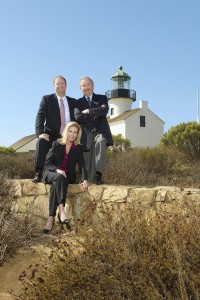Public Relations Society of America Convention Comes to San Diego
Local PRSA chapter celebrates 50 years

By Kris Grant
Dr. Glen Broom, professor emeritus at San Diego State University’s Department of Journalism and Media Studies, remembers a time when the practice of public relations was more practice oriented, not outcome oriented.
That’s a nice way of saying, that PR guys – and they were mostly guys 50 years back – were in the business of getting items into the papers.
That’s the way Dave Nuffer, founder of the public relations firm Nuffer, Smith, Tucker, remembers it. Have things changed much? Nuffer chuckles as he looks back to his first year in the business, 1959. “Well, when I first started, it was strictly publicity. Press agentry stuff. We had some vague notion that it might pay off.”
But yes, things have radically changed, Nuffer says.
Now, public relations has become a science, said Nuffer. “We are in the science of changing behavior. So, if a company wants to sell a product, increase the price of their stock, hold a special event, get elected, take care of your sales staff and employees, you had better have public relations people there because they will make a difference. It is the most important management function other than perhaps finance and the CEO’s job.”’
Nuffer points to San Diego State University as a major force that pushed the industry forward, noting that the university has played a leadership role in public relations education.
Broom, now retired from SDSU, agrees that the school enjoys an international reputation in the public relations field. “We were always ahead of the curve in terms of curriculum,” he said. “For example, we were the first to require research methods courses. I think that has spilled over into the community because so many of our graduates have stayed on here and are the leaders in the field nationwide because they have had a good preparation.”
Broom is still the editor of the definitive textbook for the industry, “Cutlip and Center’s Guide to Effective Public Relations,” and he, too, has watched and chronicled the evolution of the industry. “Today,” says Broom, “what you do speaks much louder than what you say.”
Nuffer’s first year in PR was also the same year that San Diego founded a chapter of a relatively new organization – The Public Relations Society of America. On Dec. 11, 1959, San Diego was awarded an official charter as a chapter of PRSA with 13 professionals signing the applications; there are now more than 300 members of the local chapter and more than 32,000 PRSA members internationally.
This year the chapter celebrates its 50th anniversary and, perhaps not coincidentally, the hosting of PRSA’s international convention Nov. 7-10.
Chris Wahl is president of PRSA’s San Diego chapter. His company, Southwest Strategies, in which he partners with longtime public relations pro Alan Ziegaus, specializes in public affairs work. “I got involved with PRSA because I wanted to learn more about the public relations side of the business and I’ve been able to share with the club more about what we do in the public affairs arena. It generally comes down to the same formula, of working with government and constituencies to identify solutions to complex public policy issues.”
Southwest Strategies has been quite successful in this regard, receiving two Silver Anvil awards from PRSA national last year, one for the SunRise Powerlink project of Sempra Energy, and one for the expansion of University Town Center. “We’ve been very fortunate of having smart, sophisticated clients,” said Wahl. “Clients that collaborate with you, consider your advice and treat you as an equal.”
“When we decided how to recognize our chapter’s 50th anniversary,” said Mary Krebs-Schmidt, “we decided to take a backwards glance at how positive public relations had contributed to the San Diego area over the past half century. We were amazed at the scope and variety of achievements. The PR impact was felt from business ventures to sports activities to civic causes in virtually every segment of the city.”
How did San Diego become “America’s Finest City?” It took some PR help after a national embarrassment when the Republican National Committee rescinded its decision to hold its convention in San Diego and go to Miami Beach instead. An infuriated Mayor Pete Wilson took issue with the committee’s decision and publicly stated that “We are America’s Finest City.” He challenged his public relations staff to get that fact known.
Large-scale civic celebrations took place in San Diego during the Miami convention, which national media couldn’t resist covering. San Diego went on to host the Republican Convention in 1996.
In the 1960s, Time magazine named San Diego a “bust town.” But Mayor Wilson saw Downtown’s sad condition in the early 1970s as an opportunity to kick start the economy and produce an upscale Downtown that would show off American’s Finest City. The city’s new redevelopment agency, Centre City Development Corporation, instituted a public relations campaign that began with a press conference staged in front of a notorious Downtown adult book store. There, Wilson introduced a proposed ordinance to limit adult entertainment uses. The mayor explained the issue and plans for the restoration of the 16-block area. He then invited the media inside to view adult entertainment first-hand. TV, radio and papers carried the story and the ordinance quickly became law. Today, the Gaslamp Quarter is the city’s social hub and a major economic boon for San Diego.
Another landmark that came to fruition due to public relations was Seaport Village, a 14-acre specialty center on San Diego Bay. Here, the challenge was getting people to visit a new attraction near a seedy Downtown and built on a landfill at Punta de los Muertos (Spanish for Point of the Dead). Tom Gable, Fellow PRSA, positioned the village as an escape. The first year attendance exceeded projections by 25 percent and by year two the area had more traffic than the San Diego Zoo.
When the Gemological Institute of America in Carlsbad wanted to install on its campus the largest Swarovski crystal ever made in 2002, it called upon San Diego public relations firm The Berkman Group. Jack Berkman and his team spent a full year planning the event surrounding “The Tower of Brilliance,” a one-ton octahedron resembling a natural diamond crystal, which now sits atop a large glass tower at the GIA’s main campus. “It was truly an international campaign with more than 1,000 people arriving from all over the country including the fabulous Swarovski family. It was the biggest party GIA had ever held,” Berkman recalled. Like the crystal, the PR campaign was multi-faceted, with the Berkman team working on everything from party coordination to negotiations with the FAA, which had concerns about reflections from the crystal upon pilot’s taking off from a local airport. An Associated Press photo sent all over world was picked up in thousands of locations, said Berkman. “We had more than 20 television cameras at the unveiling; it was a field day.”
A 12-year campaign that began in 1992 led by Scott McGaugh to bring the newly decommissioned USS Midway to San Diego as a museum was powered by public relations. “Much of the PR effort involved volunteers,” McGaugh said. “We didn’t place a single ad. It was all about an integrated, coordinated public relations campaign.” It came down to a final California Coastal Commission hearing. The house was packed with hundred of supporters who silently waved American flags. Ultimately the commission overruled its staff and within a year the USS Midway arrived in San Diego.
In the late ’60s, the San Diego Zoo found itself at a competitive disadvantage with new tourist attractions, inflation and soaring operating expenses. In response, the zoo created a public relations department. Zoo PR manager Bill Seaton proposed training a “goodwill ambassador.” Joan Embery, a student working in the Children’s Zoo, was selected. In 1971, Embery, with several zoo animals, appeared on the “Tonight Show with Johnny Carson.” Some 12 million viewers tuned in and Embery was on her way to stardom. With the free exposure, annual attendance topped 3 million and remained there, despite the increasing popularity of SeaWorld.
Speaking of SeaWorld, the first SeaWorld opened in 1964 in Mission Bay Park in San Diego. Few in the industry gave it any chance of success. First-year attendance was well below projections and in 1966 SeaWorld faced bankruptcy. SeaWorld’s marketing/pr director had to step up publicity efforts to get national attention so they booked its roller skating penguins on the “Jack Benny Show,” where they were a smash hit. The first killer whale arrived in the park in 1965 and became the first in a series of whales called “Shamu” and soon Shamu had its own in-house show. TV personality Hugh Downs arrived in town and rode Shamu. Today, SeaWorld attracts more than 4 million people annually and its star performer Shamu has become a household name.
The very first public relations course at San Diego State was taught by volunteers of the new PRSA chapter. “Jim Redding was president in 1963 and a bunch of people got together and said we needed to teach public relations, not just journalism,” said Broom. “And here’s the textbook, they said, ‘Effective Public Relations’ by Cutlip and Center. That first course here was being taught a mere 34 years after the first course was taught in 1929 at New York University.”
Allen Center was a former Motorola public relations executive who, upon retirement, began teaching at San Diego State. Scott Cutlip was a friend of Broom’s at the University of Wisconsin, and the two professors got together to author the first textbook. Frederick C. Whitney, a longtime public affairs professional in San Diego, became the first full-time faculty member; when he retired, Broom got the job. “I left the snow bank during the worst winter on record,” Broom recalls of his ascension to a 30-year career at SDSU.
Today, Broom’s textbook – which he still titles “Cutlip and Center’s Guide to Effective Public Relations” — is in its ninth edition and Brum has brought in a co-editor, Bey-Ling Sha, Ph.D., a faculty member at SDSU’s Journalism and Media Studies.
And while today there are many books on public relations, the Cutlip-Center textbook still dominates the market and is the guidebook for accreditation studies. And the book has definitely gone international: there’s an Indonesian translation, Japanese translation, the Latvian edition, Bulgarian edition, two Chinese editions, a Spanish edition from Spain, the Russian edition “and those are just from the eighth and ninth editions,” said Broom, as he surveyed his bookshelf.
Marisa Vallbona, Fellow PRSA, is only 45 but she says her PR career started four decades back when she was 12. “I was from Houston where it got so hot every summer you could literally fry an egg on the sidewalk,” she said. “And so that’s what my friends and I did. The egg really did fry. So one of us got the idea to call the local NBC TV station and they came out and filmed it, and I got the bug planted. I thought at first I wanted to go into broadcast journalism, but a friend who was in broadcast news said, ‘think about PR. Those people seem really happy in their work and they dress better than we do.’”
Vallbona then majored in public relations, graduating from the University of Texas.
“I remember a professor told me to get involved with PRSSA, the student society of PRSA and to become accredited as soon as I had enough experience in the field,” said Vallbona. “I’m so glad I listened. I got accredited to prove I had the knowledge for myself but it also demonstrates a commitment to the profession.
“PRSA has been so good to me. The friends I’ve made have become lifelong friends,” she said. “I found that by getting involved, serving on committees, for example, people started referring me business. That’s how I got the Blockbuster account, which I’ve had for 14 years now. And Blockbuster is what led to 7-Eleven, and then to Sempra Energy. It’s that whole biblical thing, you reap what you sow. When I think about it, PRSA changed my life.” z



